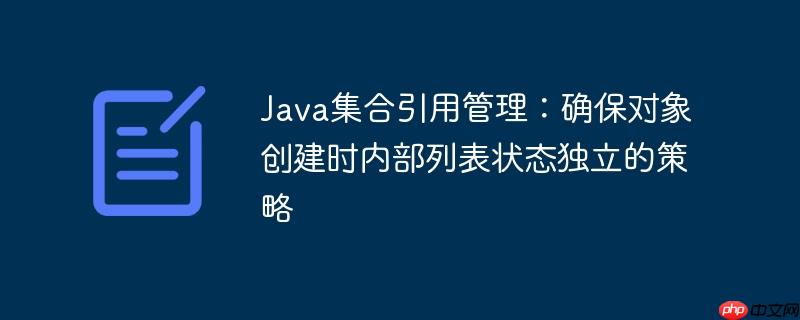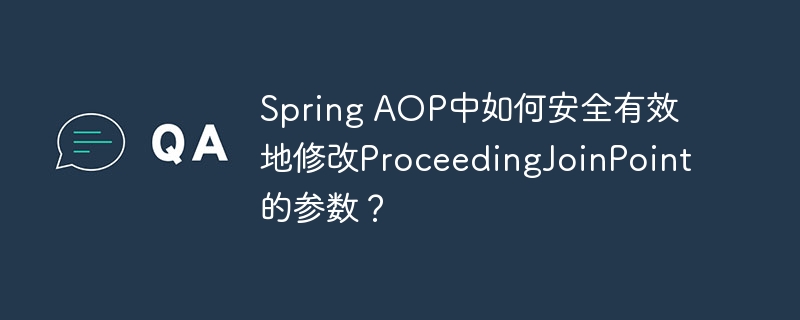
本教程探讨Java中将集合作为参数传递给构造函数时,如何避免因引用共享导致的内部数据意外更改问题。当多个对象共享同一个可变集合实例,并在外部修改该集合时,所有引用该集合的对象都会受影响。文章将详细介绍通过创建新集合实例或进行防御性复制两种有效策略,确保每个对象拥有独立且稳定的内部数据状态。
问题背景:可变集合的引用陷阱
在java中,当我们将一个对象作为参数传递给方法或构造函数时,实际传递的是该对象的引用。这意味着,如果多个对象(或方法)持有同一个可变对象的引用,并且其中一个修改了这个可变对象的状态,那么所有持有该引用的地方都会看到这些修改。
考虑以下场景,我们有一个Question类,其构造函数接受一个ArrayList<String>作为选项列表:
public class Question { private String genre; private String questionText; private ArrayList<String> choices; // 存储选项 private String answer; private String funFact; public Question(String genre, String questionText, ArrayList<String> choices, String answer, String funFact) { this.genre = genre; this.questionText = questionText; this.choices = choices; // 直接引用传入的列表 this.answer = answer; this.funFact = funFact; } // Getter methods for choices (for demonstration) public ArrayList<String> getChoices() { return choices; } @Override public String toString() { return "Question{" + "genre='" + genre + ''' + ", questionText='" + questionText + ''' + ", choices=" + choices + ", answer='" + answer + ''' + ", funFact='" + funFact + ''' + '}'; } }
现在,我们尝试在一个方法中初始化多个Question对象,并为它们设置不同的选项:
public static ArrayList<Question> allInitialQuestions(ArrayList<Question> q) { ArrayList<String> c = new ArrayList<String>(); // 声明一个ArrayList实例 // 第一个问题 c.add("Pacific"); c.add("Atlantic"); c.add("Arctic"); c.add("Indian"); q.add(new Question("Geography", "Which ocean is the largest?", c, "Pacific", "The Pacific Ocean stretches to an astonishing 63.8 million square miles!")); // 清空并重用同一个ArrayList实例 c.removeAll(c); // 问题所在:清空了c引用的列表 // 第二个问题 c.add("192"); c.add("195"); c.add("193"); c.add("197"); q.add(new Question("Geography", "How many countries are in the world?", c, "195", "Africa has the most countries of any continent with 54.")); // 再次清空并重用 c.removeAll(c); // 第三个问题 c.add("Mississippi"); c.add("Nile"); c.add("Congo"); c.add("Amazon"); q.add(new Question("Geography", "What is the name of the longest river in the world?", c, "Nile", "Explorer John Hanning Speke discovered the source of the Nile on August 3rd, 1858.")); // ... 更多问题,类似操作 ... return q; }
在上述代码中,我们创建了一个名为c的ArrayList<String>实例。每当为Question对象添加选项时,我们都向c中添加元素,然后将c传递给Question的构造函数。关键问题在于,在添加完一个Question后,我们调用了c.removeAll(c)来清空列表,以便为下一个Question重用它。
由于Question构造函数直接存储了传入c的引用,当c所指向的列表被removeAll()清空时,所有之前创建的Question对象,如果它们内部也引用着同一个ArrayList实例,它们的选项列表也会随之被清空。最终结果是,所有Question对象的choices列表都将显示最后一次添加到c中的选项,而不是它们各自初始化时应有的选项。这就是可变集合引用共享带来的陷阱。
立即学习“Java免费学习笔记(深入)”;
解决方案一:每次创建新的集合实例
解决此问题的最直接和推荐方法是,每次需要为新对象提供一个独立的集合时,都创建一个全新的ArrayList实例。这样可以确保每个Question对象都引用一个独一无二的选项列表,互不干扰。
核心思想:不再清空并重用同一个ArrayList实例,而是每次都重新初始化c。
public static ArrayList<Question> allInitialQuestions(ArrayList<Question> q) { ArrayList<String> c; // 声明引用,但暂不初始化 // 第一个问题 c = new ArrayList<String>(); // 为第一个问题创建新的ArrayList实例 c.add("Pacific"); c.add("Atlantic"); c.add("Arctic"); c.add("Indian"); q.add(new Question("Geography", "Which ocean is the largest?", c, "Pacific", "The Pacific Ocean stretches to an astonishing 63.8 million square miles!")); // 第二个问题 c = new ArrayList<String>(); // 为第二个问题创建新的ArrayList实例 c.add("192"); c.add("195"); c.add("193"); c.add("197"); q.add(new Question("Geography", "How many countries are in the world?", c, "195", "Africa has the most countries of any continent with 54.")); // 第三个问题 c = new ArrayList<String>(); // 为第三个问题创建新的ArrayList实例 c.add("Mississippi"); c.add("Nile"); c.add("Congo"); c.add("Amazon"); q.add(new Question("Geography", "What is the name of the longest river in the world?", c, "Nile", "Explorer John Hanning Speke discovered the source of the Nile on August 3rd, 1858.")); // ... 更多问题,类似操作 ... return q; }
通过c = new ArrayList<String>();这行代码,我们每次都创建了一个全新的ArrayList对象,并让c引用它。这样,当Question对象被创建时,它会获得一个指向当前独立ArrayList的引用。后续对c重新赋值为另一个新列表的操作,不会影响到之前Question对象内部存储的列表。
解决方案二:传递集合的防御性副本
另一种同样有效的策略是在Question类的构造函数中,不直接存储传入的ArrayList引用,而是存储其一个副本。这被称为“防御性复制”(Defensive Copying),它确保了对象内部状态的独立性,即使外部原始列表被修改,也不会影响到对象自身。
首先,修改Question类的构造函数:
public class Question { // ... 其他字段 ... private ArrayList<String> choices; public Question(String genre, String questionText, ArrayList<String> choices, String answer, String funFact) { this.genre = genre; this.questionText = questionText; // 进行防御性复制:创建一个新ArrayList,并将传入列表的所有元素复制进去 this.choices = new ArrayList<>(choices); this.answer = answer; this.funFact = funFact; } // ... Getter 和 toString 方法 ... }
现在,allInitialQuestions方法可以继续使用清空并重用外部ArrayList的方式,而无需担心内部状态被修改:
public static ArrayList<Question> allInitialQuestions(ArrayList<Question> q) { ArrayList<String> c = new ArrayList<String>(); // 声明并初始化一个ArrayList实例 // 第一个问题 c.add("Pacific"); c.add("Atlantic"); c.add("Arctic"); c.add("Indian"); // 构造函数会复制c的内容 q.add(new Question("Geography", "Which ocean is the largest?", c, "Pacific", "The Pacific Ocean stretches to an astonishing 63.8 million square miles!")); c.removeAll(c); // 清空c,但Question对象内部已持有副本,不受影响 // 第二个问题 c.add("192"); c.add("195"); c.add("193"); c.add("197"); q.add(new Question("Geography", "How many countries are in the world?", c, "195", "Africa has the most countries of any continent with 54.")); c.removeAll(c); // 清空c,Question对象内部已持有副本,不受影响 // ... 更多问题,类似操作 ... return q; }
这种方法的好处是,Question对象内部的choices列表是完全独立的,外部对c的任何操作(包括清空、添加、删除)都不会影响到已经创建的Question实例。缺点是每次创建Question对象时都会产生一个列表复制的开销,对于非常大的列表或性能敏感的场景可能需要权衡。
注意事项与最佳实践
- 理解Java的引用语义:这是解决此类问题的基础。Java中对象变量存储的是对象的引用,而不是对象本身。当传递对象变量时,传递的是引用值的副本,而不是对象本身的副本。
- 可变性与不可变性:如果一个对象包含可变集合,那么这个对象本身就不是完全不可变的。为了实现真正的不可变性,不仅需要防御性复制传入的可变集合,还需要确保通过getter方法返回的集合也是不可修改的(例如,使用Collections.unmodifiableList())。
- 选择合适的策略:
- 新建实例 (c = new ArrayList<String>();):当外部列表不再需要保留其当前状态,或者每次都需要一个全新的列表时,这是最简洁高效的方法。它避免了不必要的复制开销。
- 防御性复制 (this.choices = new ArrayList<>(choices);):当外部列表可能在其他地方被继续使用或修改,并且希望确保对象内部状态不被外部干扰时,这是更好的选择。它提供了更强的封装性和安全性。
- 避免c.removeAll(c):无论采用哪种解决方案,c.removeAll(c)这种写法通常不如c.clear()直观。虽然它们都能清空列表,但clear()是更推荐的语义化方法。然而,在上述两种解决方案中,最佳实践是避免重用同一个列表实例,或者在构造函数中进行防御性复制,从而避免清空操作引发的问题。
总结
在Java开发中,处理集合引用时务必警惕可变性带来的副作用。当一个对象内部包含对可变集合的引用时,外部对该集合的修改可能会意外地改变对象的状态。通过每次创建新的集合实例或在构造函数中进行防御性复制,我们可以有效地确保每个对象拥有独立且稳定的内部数据状态,从而避免数据混乱和难以调试的bug。理解并正确应用这些策略,是编写健壮、可维护Java代码的关键。


















